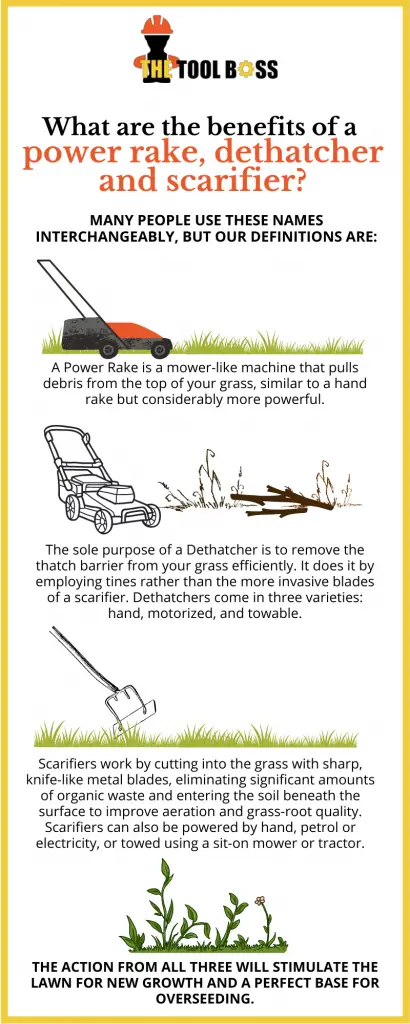Getting the perfect lawn can be a labor of love, but sometimes hard work needs to take over.
It can be a long and tiresome process to get a lawn that looks lush and healthy, just like you see in magazines.
You want a lawn to show off to neighbors and friends—the answer to the stunning lawn you are looking for is dethatching and overseeding.
This is where lawn maintenance comes in, adding grass seed to bare spots in your existing lawn to give it a new lease of life.
Regular care will have your lawn looking thick, healthy and a vibrant green that looks like it’s painted.
However, before you put the new grass seed down, you need to make sure your lawn’s in the best condition beforehand.
This means preparing the lawn properly by completing regular maintenance, mowing it and getting rid of any thick layers of thatch you may have.

Thatch Removal
Thatch is a layer of tangled roots, grass and stems.
It’s easy to identify thatch as it’s spongy to the touch, and it’s the thing that many homeowners dread.
If you leave a thick thatch layer on your lawn’s surface, it will stop any weed and feed absorption and grass seeds from germinating, meaning that your new grass won’t grow.
So, when it comes time to carry out lawn thatch removal, you need the right tools and quite an aggressive approach.
This approach makes the job easier and gets it done more quickly than doing it manually. You can choose the right tools to use and use power rakes, dethatchers or scarifiers.
These all do a great job, but which is the best?
We’ll let you know about all three and will let you know which would be the right tool for the job you have at hand.

What Is a Power Rake?
A power rake is, as the name suggests, a powerful motorized rake. It looks like a regular lawn mower but does the same job as a manual hand leaf rake—with a great deal more power—and it covers a larger area quickly.
Taking time to power rake is an ideal way to remove old grass clippings, thin layers of thatch and other lawn-top debris. Power raking removes the lawn thatch without causing the damage that other tools can cause.
A power rake scours the top layer of the lawn to loosen the debris and dead grass, and then collects it, ideally, leaving the soil surface unbroken, but more exposed than previously.
Benefits of Power Raking
The benefits of using a power rake are:
- Power raking removes all unwanted dead roots, stems, and thatch buildup.
- Power raking stimulates new growth and results in a thicker, healthier lawn.
- Power raking increases the amount of water and fertilizer that is absorbed by the grass roots through the earth.
If you don’t complete your lawn maintenance correctly, your lawn will form a layer of dead debris on top.
The living grass underneath this will then develop brown spots, and if left, it will turn into thatch, making your job of removing it with your power rake even harder.
The raking discs of the power rake should be kept relatively high to make sure that you don’t remove the good grass by mistake.
If you want to lower the blades on your power rake, do this slowly, a bit at a time, ensuring you don’t damage your lawn.
The best time for power raking is in late spring or early summer as the lawn is growing so it has lots of time to recover and repair itself fully.
Power raking will allow you to remove the dead grass and overseed the lawn, giving you a new lawn before the hot summer months.
What Is a Dethatcher?
A dethatcher is a device that’s similar to a power rake but is made specifically to remove thatch from your lawn.
There are three different kinds of dethatchers out there.
Whichever Is best will depend on the size of your lawns and the amount of thatch that you need to remove.
A manual dethatcher is the cheapest option. However, this takes hard manual labor, even to do a small area.
A tow behind dethatcher is great for large areas as it can be easily attached to a ride-on mower.
The best option for a medium to large-sized lawn is a motorized dethatcher. This equipment will allow you to pull up a large amount of thatch without damaging the lawn underneath.
A dethatcher, unlike power rakes, uses curled spring tines that comb across the top of the grass, pulling up any thatch to the surface of the lawn.
Dethatching with a dethatcher is best done in early spring for warm-season grasses or early fall for cool-season grasses. You can then follow this with your fertilizing program and seasonal maintenance.
What Is a Scarifier?
A lawn scarifier will remove any heavy thatch from your lawn so that oxygen and nutrients can get into the soil. The removal of the thatch will enable strong, healthy roots from your grass plants to grow.
When the water can’t get to the soil through the hatch, it will sit on top of the grass and encourage moss and creeping weeds to grow. These weeds and moss will ultimately damage the lawn and stop your grass from growing.
A scarifier breaks up the thick layer of thatch by cutting through the topsoil.
It does this by digging into the earth with sharp tines made from metal. The scarifier blades dig deeper than a power rake or a dethatcher, giving you a better result if you have excess thatch that’s more than half an inch thick.
Scarifying the lawn aerates it and gives new life to your compacted soil. It also makes the soil looser, and you are able to grow new grass from seed.
Scarifying can be done all year round when needed. The best time to do it would be early spring, when you’re getting your lawn ready for the new growing season.
Which Tool is Best For You?
All three tools are all used to remove thatch from your lawn and prepare it for overseeding.
However, they all offer something slightly different. The main difference is the pressure that they use to get rid of your thatch.
A power rake is better if you have lawn debris and only a thin layer of dead thatch. It uses flat spinning metal bars that act like raking discs or tines.
This is a gentler way of clearing the thatch than using a dethatcher or scarifier, but you will need to aerate the lawn after this, before overseeding.
A dethatcher uses curled metal spring tines rather than blades to cut through the thatch and into the soil. It will remove thicker layers of thatch than the power rake. A towable dethatcher can also cover much bigger areas.
A scarifier has metal blades that cut into the soil underneath the lawn. This allows the scarifier to get deeper into the soil, loosening it far easier than with the other tools. It is great for bigger jobs, such as removing thicker layers of thatch and releasing compacted soil.
Whether you choose a power rake, dethatcher or scarifier, you should make sure that you always have your blades set at their highest level to start.
You may be tempted to lower them quickly to get the job completed, but this will cause more damage to your lawn than good and may rip the whole lawn up. Lower the blades gradually once you know what you’re doing.
All three tools give you a great example of a job done well and excellent results if used correctly and appropriately. The one you choose will depend on the size of your garden, how serious your thatch problem is and how much thatch needs removing.

What Works Best?
Thatch can be a big issue on some lawns, and you need to clear this as soon as you can, keeping on top of the problem. Regular maintenance will make thatch easier to remove, rather than just doing it once each year when the thatch is at its worst.
So, Power Rake vs. Dethatcher vs. Scarifier—Which is best?
If you have a thin layer of thatch on your lawn the best option would be a power rake as this is gentler on your lawn and will remove the surface debris. A dethatcher is ideal for a thicker layer of thatch and slightly compacted soil as this will cut through it with ease.
If you have a serious problem with the thatch on your lawn you need to bring in a scarifier. This will get rid of the toughest thatch and will get deep into the soil, giving your lawn a new lease of life.
We hope you’ve enjoyed our guide, now go out there and get to work, creating the stunning and healthy grass lawn that you want and deserve!
